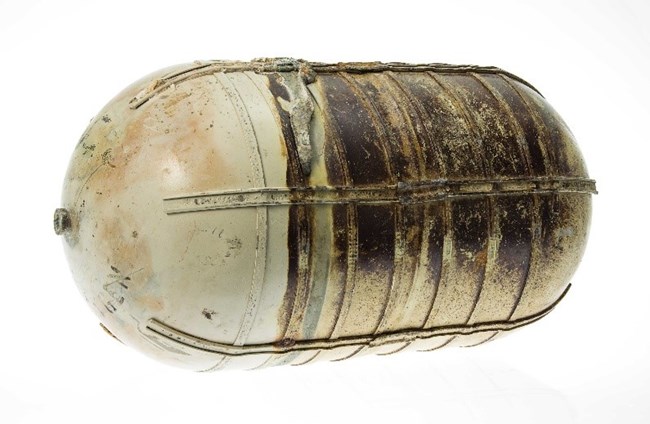Last updated: March 17, 2023
Article
Artifact Spotlight: B29 Superfortress Oxygen Tank

Andy Cattoir, NPS
Lake Mead is a man-made lake which formed after the 1930s construction of the Hoover Dam. LAKE is the United States’ first recreation area, spanning across 1.5 million acres of Nevada and Arizona wilderness. Lake Mead is the largest reservoir in the United States, with over 750 miles of shoreline. It is an oasis in the vast surrounding desert. Depending on rainfall levels and other environmental pressures, Lake Mead’s water level fluctuates seasonally with a maximum depth of over 1000 ft.
The region’s colossal lakes and isolated desert make it an ideal location for the surrounding military bases and test range sites. During the emergence of the cold war in the 1940s, the lake and surrounding areas were used to field test new weapon and aircraft technology. On the morning of July 21, 1948, a four-man crew piloting a B-29 Superfortress flew above the lake conducting upper atmospheric range tests. After taking several measurements, the pilot was instructed to fly as low to the water as possible. Despite the crystal-clear sunny skies and ideal flight conditions, sunlight reflecting off the water paired with an improperly calibrated altimeter led both the pilot and co-pilot to miscalculate their altitude. Flying at nearly 250 mph, the plane made contact with the surface of the lake, skimming for nearly half a mile before losing multiple engines and beginning to sink. Fortunately, due to the quick reaction of the pilots and crew, the entire team escaped miraculously unharmed (save for one broken arm) to emergency rafts where they awaited rescue.

NPS Gallery *Images credited to NPS without any copyright symbol are public domain
While the site is being carefully protected, commercial guided tours from accredited diving companies offer limited opportunities to see the site up close. Other sunken treasures around the site, including two boat wrecks, a sunken 38-foot tow barge, and a white gypsum reef are accessible to guests with scuba licenses.
To read more about diving opportunities at Lake Mead, click here.
Article written by Audrey Nelson
for "A Day in the Life of a Fellow" Article Series
National Park Service - Workforce Management Fellow
in Partnership with Northwest Youth Corps (NYC)
for "A Day in the Life of a Fellow" Article Series
National Park Service - Workforce Management Fellow
in Partnership with Northwest Youth Corps (NYC)
